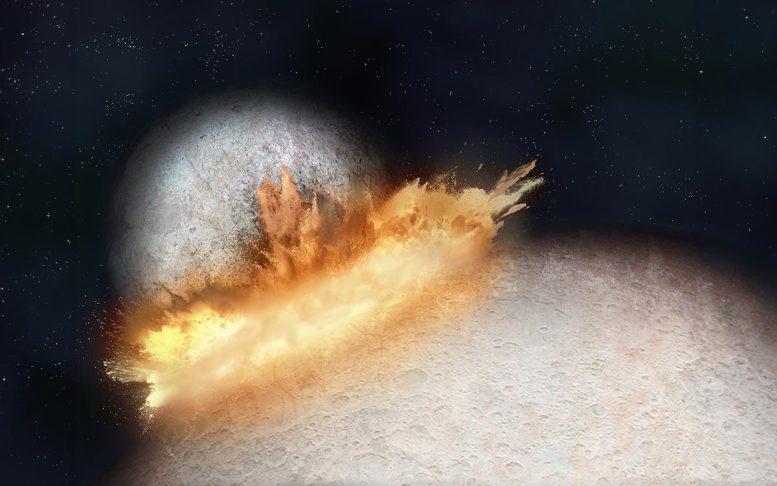
Artistic representation of the huge and slow impact on Pluto that led to the heart-shaped structure on its surface. Credit: University of Bern, Thibaut Roger, edited
The mystery of how Pluto got a giant heart-shaped feature on its surface has finally been solved by an international team of astrophysicists led by the University of Bern and members of the National Center of Competence in Research (NCCR) PlanetS. The team is the first to successfully reproduce the unusual shape with numerical simulations, attributing it to a giant and slow oblique-angle impact.
Ever since the cameras of NASA’s New Horizons mission discovered a large heart-shaped structure on the surface of the dwarf planet Pluto in 2015, this “heart” has puzzled scientists because of its unique shape, geological composition and elevation. Scientists from the University of Bern in Switzerland and the University of Arizona used numerical simulations to investigate the origins of Sputnik Planitia, the western teardrop-shaped part of Pluto’s heart surface feature.
According to their research, Pluto’s early history was marked by a cataclysmic event that formed Sputnik Planitia: a collision with a planetary body a little over 400 miles in diameter, roughly the size of Arizona from north to south. The team’s findings, published in Nature Astronomy, also suggest that the inner structure of Pluto is different from what was previously assumed, indicating that there is no subsurface ocean.
“The formation of Sputnik Planitia provides a critical window into the earliest periods of Pluto’s history,” said Adeene Denton, a planetary scientist at the UArizona Lunar and Planetary Laboratory who co-authored the paper. “By expanding our investigation to include more unusual formation scenarios, we’ve learned some totally new possibilities for Pluto’s evolution, which could apply to other Kuiper Belt objects as well.”
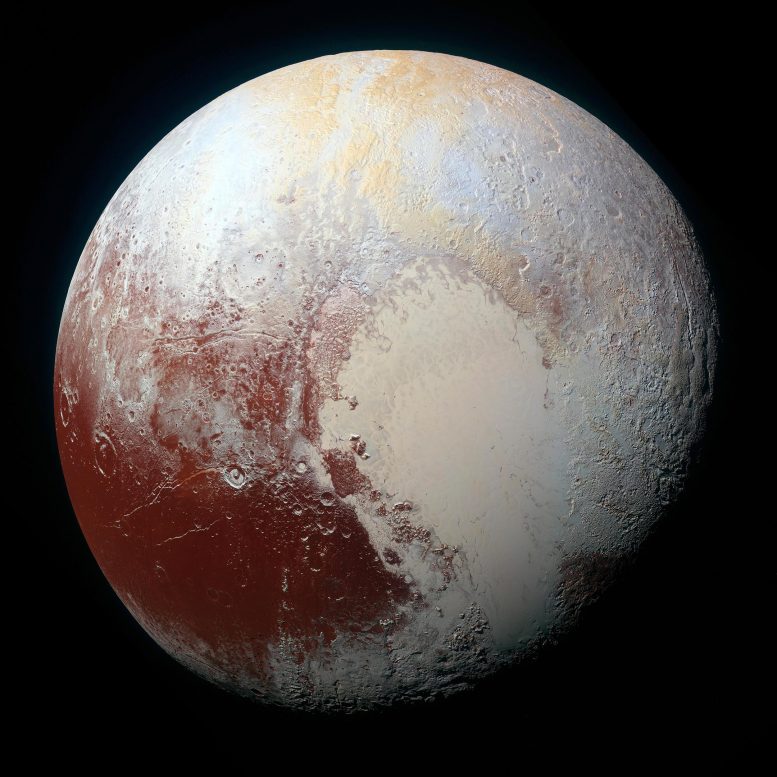
View of Pluto taken by NASA’s New Horizons space probe on July 14, 2015. Credit: NASA/Johns Hopkins University Applied Physics Laboratory/Southwest Research Institute
A Divided Heart
The “heart,” also known as the Tombaugh Regio, captured the public’s attention immediately upon its discovery. But it also immediately caught the interest of scientists because it is covered in a high-albedo material that reflects more light than its surroundings, creating its whiter color. However, the heart is not composed of a single element. Sputnik Planitia covers an area of approximately 750 by 1,250 miles, equivalent to a quarter of Europe or the United States. What is striking, however, is that this region is roughly 2.5 miles lower in elevation than most of Pluto’s surface.
“While the vast majority of Pluto’s surface consists of methane ice and its derivatives covering a water-ice crust, the Planitia is predominantly filled with nitrogen ice, which most likely accumulated quickly after the impact due to the lower altitude,” said the lead author of the study, Harry Ballantyne, a research associate at Bern. The eastern part of the heart is also covered by a similar but much thinner layer of nitrogen ice, the origin of which is still unclear to scientists, but is probably related to Sputnik Planitia.
An Oblique Impact
The elongated shape of Sputnik Planitia and its location at the equator strongly suggest that the impact was not a direct head-on collision but rather an oblique one, according to Martin Jutzi of the University of Bern, who initiated the study. Like several others around the world, the team used Smoothed Particle Hydrodynamics simulation software to digitally re-create such impacts, varying both the composition of Pluto and its impactor, as well as the velocity and angle of the impactor. These simulations confirmed the scientists’ suspicions about the oblique angle of impact and determined the composition of the impactor.
“Pluto’s core is so cold that the rocks remained very hard and did not melt despite the heat of the impact, and thanks to the angle of impact and the low velocity, the core of the impactor did not sink into Pluto’s core, but remained intact as a splat on it,” Ballantyne said. This core strength and relatively low velocity were key to the success of these simulations: Lower strength would result in a very symmetrical leftover surface feature that does not look like the teardrop shape observed by NASA’s New Horizons probe during its fly-by of Pluto in 2015.
“We are used to thinking of planetary collisions as incredibly intense events where you can ignore the details except for things like energy, momentum and density,” said Lunar and Planetary Laboratory professor and study co-author Erik Asphaug, whose team has collaborated with its Swiss colleagues since 2011, exploring the idea of planetary “splats” to explain, for instance, features on the far side of Earth’s moon. “In the distant solar system, velocities are so much slower than closer to the sun, and solid ice is strong, so you have to be much more precise in your calculations. That’s where the fun starts.”
No Subsurface Ocean on Pluto
The current study sheds new light on Pluto’s internal structure as well. In fact, a giant impact like the one simulated is much more likely to have occurred very early in Pluto’s history than during more recent times. However, this poses a problem: A giant depression like Sputnik Planitia is expected to slowly drift toward the pole of the dwarf planet over time due to the laws of physics, since it is less massive than its surroundings. Yet it has remained near the equator. The previous theorized explanation invoked a subsurface liquid water ocean, similar to several other planetary bodies in the outer solar system. According to this hypothesis, Pluto’s icy crust would be thinner in the Sputnik Planitia region, causing the ocean to bulge upward, and since liquid water is denser than ice, causing a mass surplus that induces migration toward the equator.
The new study offers an alternative perspective, according to the authors, pointing to simulations in which all of Pluto’s primordial mantle is excavated by the impact, and as the impactor’s core material splats onto Pluto’s core, it creates a local mass excess that can explain the migration toward the equator without a subsurface ocean, or at most a very thin one.
Denton, who already has embarked on a research project to estimate the speed of this migration, said this novel and creative origin hypothesis for Pluto’s heart-shaped feature may lead to a better understanding of the dwarf planet’s origin.
Reference: “Sputnik Planitia as an impactor remnant indicative of an ancient rocky mascon in an oceanless Pluto” by Harry A. Ballantyne, Erik Asphaug, C. Adeene Denton, Alexandre Emsenhuber and Martin Jutzi, 15 April 2024, Nature Astronomy.
DOI: 10.1038/s41550-024-02248-1

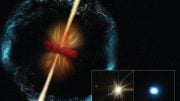

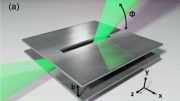
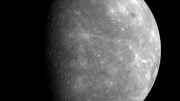




The Heart Shaped Area On Pluto has two different surface textures. The left half is rather smooth and tier drop shaped, and the right half has a rougher texture, and both halves do not have the number of impact craters that one can see on the majority of Pluto’s surface. Impact crater sizes and frequency should fall off by the square of the elapsed time since initial formation. This means Pluto is the oldest, the right half of the heart shape is of medium age, and the left half is fairly young as it is still quite smooth. This is of course if there is only one supply of material that is impacting planets. If the material supply is cyclical as we orbit the Galaxy, then most of the Impact events are from the last few cycles, and these may, or, they may not, have their supply of materials periodically refreshed by larger Orb Impact events. We must remember that almost all impact events raise the Mass and Volume of the Orb being impacted.
Think About It.